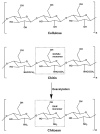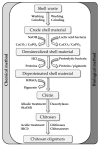Conversion of Chitin to Defined Chitosan Oligomers: Current Status and Future Prospects
- PMID: 31374920
- PMCID: PMC6723438
- DOI: 10.3390/md17080452
Conversion of Chitin to Defined Chitosan Oligomers: Current Status and Future Prospects
Abstract
Chitin is an abundant polysaccharide primarily produced as an industrial waste stream during the processing of crustaceans. Despite the limited applications of chitin, there is interest from the medical, agrochemical, food and cosmetic industries because it can be converted into chitosan and partially acetylated chitosan oligomers (COS). These molecules have various useful properties, including antimicrobial and anti-inflammatory activities. The chemical production of COS is environmentally hazardous and it is difficult to control the degree of polymerization and acetylation. These issues can be addressed by using specific enzymes, particularly chitinases, chitosanases and chitin deacetylases, which yield better-defined chitosan and COS mixtures. In this review, we summarize recent chemical and enzymatic approaches for the production of chitosan and COS. We also discuss a design-of-experiments approach for process optimization that could help to enhance enzymatic processes in terms of product yield and product characteristics. This may allow the production of novel COS structures with unique functional properties to further expand the applications of these diverse bioactive molecules.
Keywords: chitin; chitosan; chitosan oligomers; deacetylation; depolymerization; design of experiments; enzymatic conversion.
Conflict of interest statement
The authors declare no conflict of interest.
Figures





Similar articles
-
Structure and function of enzymes acting on chitin and chitosan.Biotechnol Genet Eng Rev. 2010;27:331-66. doi: 10.1080/02648725.2010.10648156. Biotechnol Genet Eng Rev. 2010. PMID: 21415904 Review.
-
The cell factory approach toward biotechnological production of high-value chitosan oligomers and their derivatives: an update.Crit Rev Biotechnol. 2017 Feb;37(1):11-25. doi: 10.3109/07388551.2015.1104289. Epub 2015 Nov 2. Crit Rev Biotechnol. 2017. PMID: 26526199 Review.
-
Enzymatic production of all fourteen partially acetylated chitosan tetramers using different chitin deacetylases acting in forward or reverse mode.Sci Rep. 2017 Dec 18;7(1):17692. doi: 10.1038/s41598-017-17950-6. Sci Rep. 2017. PMID: 29255209 Free PMC article.
-
Biodegradation and Prospect of Polysaccharide from Crustaceans.Mar Drugs. 2022 May 2;20(5):310. doi: 10.3390/md20050310. Mar Drugs. 2022. PMID: 35621961 Free PMC article. Review.
-
Use of chitin and chitosan to produce new chitooligosaccharides by chitinase Chit42: enzymatic activity and structural basis of protein specificity.Microb Cell Fact. 2018 Mar 22;17(1):47. doi: 10.1186/s12934-018-0895-x. Microb Cell Fact. 2018. PMID: 29566690 Free PMC article.
Cited by
-
Heterologous Expression and Characterization of a High-Efficiency Chitosanase From Bacillus mojavensis SY1 Suitable for Production of Chitosan Oligosaccharides.Front Microbiol. 2021 Nov 29;12:781138. doi: 10.3389/fmicb.2021.781138. eCollection 2021. Front Microbiol. 2021. PMID: 34912320 Free PMC article.
-
Expression and Characterization of a Novel Cold-Adapted Chitosanase from Marine Renibacterium sp. Suitable for Chitooligosaccharides Preparation.Mar Drugs. 2021 Oct 21;19(11):596. doi: 10.3390/md19110596. Mar Drugs. 2021. PMID: 34822467 Free PMC article.
-
Biochemical Properties of a Cold-Active Chitinase from Marine Trichoderma gamsii R1 and Its Application to Preparation of Chitin Oligosaccharides.Mar Drugs. 2023 May 29;21(6):332. doi: 10.3390/md21060332. Mar Drugs. 2023. PMID: 37367657 Free PMC article.
-
Anti-inflammatory activity of soluble chito-oligosaccharides (CHOS) on VitD3-induced human THP-1 monocytes.PLoS One. 2021 Feb 3;16(2):e0246381. doi: 10.1371/journal.pone.0246381. eCollection 2021. PLoS One. 2021. PMID: 33534833 Free PMC article.
-
In vitro Preparation and Evaluation of Sustained-Release Microcapsules of Salvianolic Acid.Drug Des Devel Ther. 2021 Apr 21;15:1623-1631. doi: 10.2147/DDDT.S294314. eCollection 2021. Drug Des Devel Ther. 2021. Retraction in: Drug Des Devel Ther. 2021 Dec 23;15:5133-5134. doi: 10.2147/DDDT.S354555. PMID: 33907382 Free PMC article. Retracted.
References
-
- Kim S.-K. Chitin, Chitosan, Oligosaccarides and Their Derivatives. Volume 1 CRC Press; Boca Raton, FL, USA: 2011.
-
- Rinaudo M. Chitin and chitosan: Properties and applications. Prog. Polym. Sci. 2006;31:603–632. doi: 10.1016/j.progpolymsci.2006.06.001. - DOI
Publication types
MeSH terms
Substances
LinkOut - more resources
Full Text Sources

